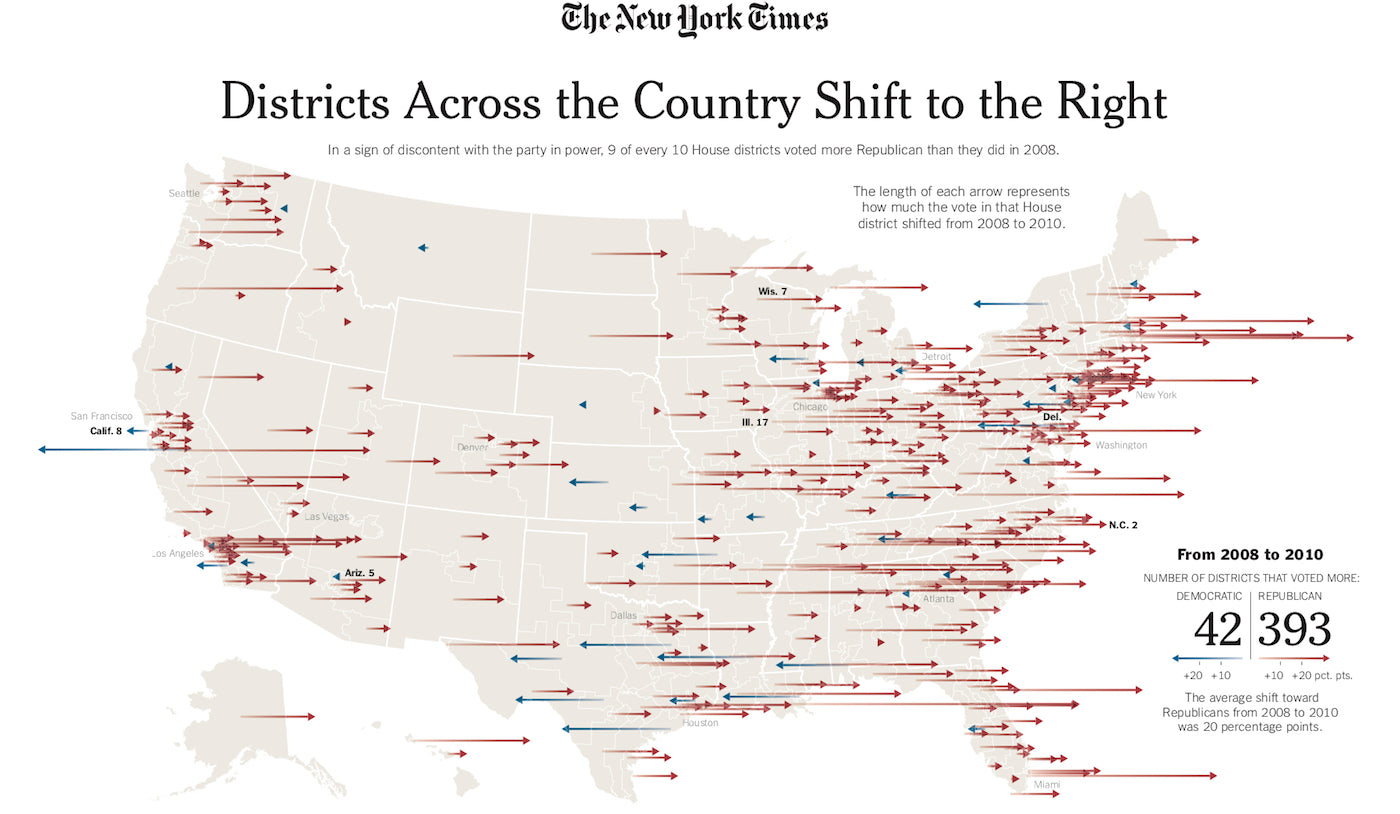
Visualizing A New, New York Times
The iconic infographics of Amanda Cox and how she changed one of the world’s most respected newspapers from within
Amanda Cox was a driving force behind the New York Times’ presentation of visual information this past decade. To make her infographics, she focuses on the unique characteristics of the data, which often yields profound insights. Her interactive visualizations display everything from election results to long-term socioeconomic developments in a comprehensible and accessible way.
Cox was a mere intern at the New York Times (NYT) when she stood up to an external contributor who had wrongly changed a definition on a graphic: she stopped him in his tracks. The members of the paper’s graphics team, headed by Steve Duenes, were impressed by this display of courage in someone so young. They were not the only ones. Dean Baquet, the newspaper’s executive editor, remembered the episode when announcing Cox’s appointment in 2016 as editor of The Upshot, a microsite launched in 2014 that provides analysis on politics, policy, and daily life. Baquet began his announcement by saying: “She’s creative and collegial and has a rare force of intellect. She is responsible for some of the most innovative work the Times has done over the last decade, and her input has lifted the work of dozens of Times journalists.”

Cox interned at the NYT in the summer of 2004 and was hired as graphics editor the following year. Her work on The Upshot began concurrently with the start of the project, as she helped shape its vision and do the reporting. At first, Cox was torn about making the change from reporter to editor. “There’s a little bit of self-loathing amid the excitement, like somehow being a reporter is more important. But keeping a beginner’s mind is probably healthy,” she said.
When she was a child, Cox’s parents, both auditors, subscribed to the Wall Street Journal and Newsweek, which she remembers reading a fair amount. An aptitude test indicated that she would make an excellent air traffic controller, but she was leaning toward actuarial science. In the end, she studied Mathematics and Economics at St. Olaf College, a small liberal arts school in Minnesota. After graduating, she worked for two years as an assistant researcher at the Federal Reserve. “My favorite thing at the Fed was making charts,” she admits. Later, she earned a master’s in statistics from the University of Washington. Unsure of which career path to follow, she applied to several different jobs and companies in order to see which of the rejection letters upset her the most.“I thought it might reveal some hidden preferences,” she explained. Like an insightful graphic, the initial “no” from the NYT pointed the way.

This graphic uses data provided by the American Time Use Survey to show how employed and unemployed people spend their time. The timeless run horizontally while the percentages of various activities are shown vertically: both use the same color code. (Graphic: Amanda Cox, Kevin Quealy, Amy Schoenfeld, Visual Journalism)
In 2009, the NYT won the prize for Best of Show at the 19th Malofiej Awards for the same infographic in both the print and digital media categories: “Ebb and Flow at the Box Office,” which tracked the earnings of several films, was produced by none other than Amanda Cox. The graphic, which she does not consider so significant today, triggered a definite trend. It was a minor revolution that others have repeatedly imitated. She went on to produce a visually similar piece in 2015: “How Different Groups Spend Their Day” earned a Silver Medal at the 24th Malofiej Awards. If asked which of her graphics is her favorite, she prefers the ones she made back when she and her team had the nerve to put something unorthodox on the paper’s homepage, such as “Flying Boxes,” in 2008. The piece analyzed the race between Barack Obama and Hillary Clinton for the Democratic Party nomination. For Cox, it’s one of a kind. “I can remember feeling like we had just stolen a car. A graphic about the Obama/Clinton primaries feels so dated now, and every time I give a talk I tell myself that I should take it out. But I always throw it back in at the last minute,” she admits. Cox uses a program called R, which she believes is the best ever created, to make pieces like that one. According to her, data visualization is so valuable because it gives people “the ability to see things (they) didn’t even know how to ask about.”
“Words in a graphic should highlight the relevant pattern or an expert’s interpretation, and not merely say ‘Here is the data’”
Another one of her infographic highlights at the NYT was the first time she coded a graphic by herself. “Fractions of a Second: An Olympic Musical,” from 2010, analyzed why differences between competitors are greater in some sports than in others. When speaking about works by others that have had an impact on her, Cox is enthusiastic. “Golan Levin’s ‘Axis’ in 2002 blew my mind. It was very early interactive data art at the Whitney Museum, sort of riffing on George W. Bush’s ‘axis of evil’ statement. Also, Jason Salavon’s averaging photos that reveal the average shape or essence of things. And I remember thinking Ben Wershkul was a small god the first time he put interactive House results online, even if the idea of boxes with rollovers seems like the opposite of exciting now,” she states. Above all, though, she admires Steve Duenes, her chief mentor, and head of infographics at the NYT. Once someone asked Cox and her colleague, Hannah Fairfield, what made the graphics department at the NYT so extraordinary. Cox gave a roundabout answer about how a large group of talented people making interesting things will attract more talented people who will, in turn, produce interesting things and be more willing to experiment, etc. Fairfield, however, gave a much simpler answer: “She said it was Steve.”

Amanda Cox is editor of The New York Times’s The Upshot section. Ms. Cox’s first position at The Times was as a graphics editor, a position she held from 2005 to 2016. (Photo: Visual Journalism)
Cox admits that perhaps the infographics of Fortune magazine in the 1950s were better than the majority of those created today, but the data journalism website FiveThirtyEight “still wins the 2-column chart game.” Moreover, she would happily have authored any of Ben Wellington’s “out-of-the-box Excel charts” over her own. For Cox, the average graphic today is better than the ones made 10 years ago, although not as original or imaginative. “Data graphics are tough on phones, though this has forced us to be simpler—or to put more effort into the analysis,” she explains. She has no doubts about what is in store: more profound analysis, more animated GIFs instead of clicks, and pieces created specifically for mobile devices. She insists that data visualization will drive journalism more than the other way around, as has been the case previously. This will lead to hiring people skilled in machine learning: a new type of infographer who she believes “will write with more poetry and authority than most of us today.”
“Templates can be safety nets. The best stories emerge as something crafted, something that makes use of the unique characteristics of the data in question”
For years, the NYT has led the way in turning infographers into true reporters and editors. In fact, they are doing increasingly more reporting and writing in the production of hybrid projects that would not have been categorized as graphics before. Many of Cox’s team’s pieces are what Cox calls simple, static graphics since they are not overly obsessed with interactivity. Text, on the other hand, is of vital importance. “The annotation layer is critical. Words in a graphic should highlight the relevant pattern or an expert’s interpretation, and not merely say ‘Here is the data,’” she pointed out recently in an interview with simplystatistics.org. This statement underlines Cox’s focus on her craft and the readers. David Leonhardt, her predecessor as editor of The Upshot, called her “the smartest journalist I’ve ever worked with.” Baquet, her boss, says that his favorite graphic is “Election Night Gauges,” which Cox and Nate Cohn produced the day of Donald Trump’s victory in November 2016. In Baquet’s opinion, this project, which correctly anticipated the results, “meant the reinvention of election-night coverage.”

This graphic, published in January 2008, examined volatility in the stock market, particularly in the Dow Jones Index. It combines daily fluctuations with yearly Dow Jones performance, revealing that the lines of a fever chart are never truly straight. (Graphic: Soap Box NYT, Visual Journalism)
Cox does not consider herself to be an expert in statistics. Nevertheless, she continually dives into the oceans of data. “My goal is to find the things I’m missing,” she declares. She believes that the effectiveness of visual elements, whether infographics or design, has nothing to do with the use of space or typography but with empathy. The mission of the infographer is, as she once said at an OpenVis conference, “to create visualizations that the readers can understand and which engage them emotionally.”
In her own work, Cox follows this mission. “You Draw It: How Family Income Predicts Children’s College Chances,” from 2015, is a prime example. The graphics highlight the linear relationship between income and education for young people. “The chart is just a line, but it’s a soul-crushing line. I think about it all the time now,” Cox says. Similarly, there is “Best and Worst Places to Grow Up,” which found that working-class children raised in Manhattan have lower odds of being successful later in life. When reporting on issues as important as these, she avoids using a standard method. “Templates can be safety nets. The best stories emerge as something crafted, something that makes use of the unique characteristics of the data in question,” she says. Cox made her mark as a hungry, young individual eager to question what was presented in front of her. From her days as an intern to her groundbreaking visual infographics, Cox championed a new direction for the New York Times that made it a pioneering voice in visual journalism. Today, she continues to bring data alive in ever galvanizing formats and is without a doubt one of the most respected names in her field.
Journalism can be made simpler, and better through data, learn more about Visual Journalism.


